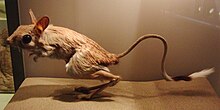Dipodoidea
| Dipodidae Temporal range: Late Eocene–Recent |
|
|---|---|
 |
|
| Jaculus orientalis | |
| Scientific classification | |
| Kingdom: | Animalia |
| Phylum: | Chordata |
| Class: | Mammalia |
| Order: | Rodentia |
| Suborder: | Myomorpha |
| Superfamily: | Dipodoidea |
| Family: |
Dipodidae Fischer de Waldheim, 1817 |
| Subfamilies | |
|
Allactaginae |
|
Allactaginae
Cardiocraniinae
Dipodinae
Euchoreutinae
Sicistinae
Zapodinae
The Dipodidae, or dipodids, are a family of rodents found across the Northern Hemisphere, the sole family in the superfamily Dipodoidea. This family includes over 50 species among the 16 genera. They include the jerboas, jumping mice, and birch mice. Different species are found in grassland, deserts, and forests. They are all capable of saltation (jumping while in a bipedal stance), a feature that is most highly evolved in the desert-dwelling jerboas.
Dipodids are small to medium-sized rodents, ranging from 4 to 26 cm (1.6 to 10.2 in) in body length, excluding the tail. They are all adapted for jumping, although to varying degrees. The jerboas have very long hind legs which, in most species, include cannon bones. They move either by jumping, or by walking on their hind legs. The jumping mice have long feet, but lack the extreme adaptations of the jerboas, so that they move by crawling or making short hops, rather than long leaps. Both jerboas and jumping mice have long tails to aid their balance. Birch mice have shorter tails and feet, but they, too, move by jumping.
Most dipodids are omnivorous, with a diet consisting of seeds and insects. Some species of jerboa, however, such as Allactaga sibirica, are almost entirely insectivorous. Like other rodents, they have gnawing incisors separated from the grinding cheek teeth by a gap, or diastema. The dental formula for dipodids is:
...
Wikipedia
